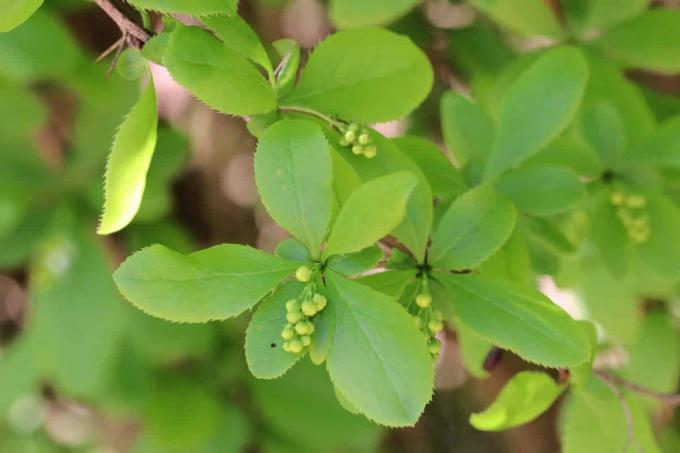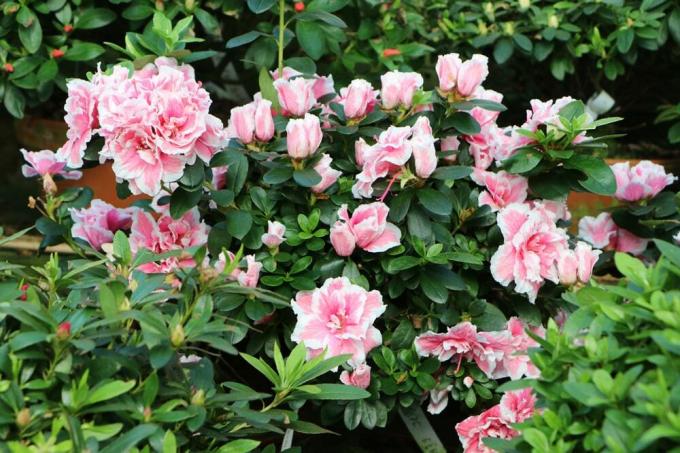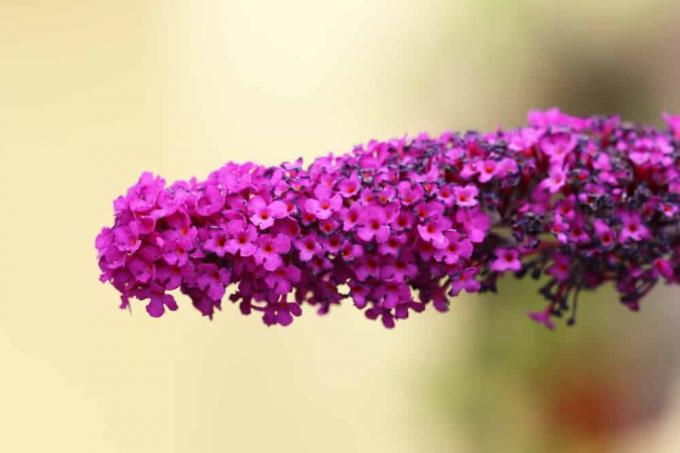

Table of contents
- Barberry: ingredients
- Toxic effect in humans
- Toxic to pets?
- effect on horses
Barberries are well protected against a variety of predators. The main reason for this is the thorns. In this article you can find out whether other parts of the plant are also protected due to poison.
Barberry: ingredients
Berberis vulgaris is one of the slightly poisonous plants that contain a cocktail of toxic alkaloids in a large number of parts of the plant. Affected plant parts are:
- Root bark (highest toxic effect)
- root
- stem bark
- leaves
- Wood
It is precisely these parts of the plant that fortunately have the least irritating effect on people and in most cases are not consumed. Especially the thorn-armed leaves and shoots are to be mentioned, which could lead to injuries if they come into contact with them. That makes them all the more popular as a hedge. The flowers and berries, on the other hand, are non-toxic. They contain no toxins and are safe to consume. The toxins it contains are various alkaloids, the most important of which is berberine. Berberine has a significant toxicity that accounts for the majority of cases of poisoning. Other alkaloids like berbamine or palmatine don't affect the body as much.
The toxicity depends on the concentration of the ingredients within the plant parts:
- Roots: up to 15 percent
- other plant parts: up to 3 percent
Other ingredients found in barberry include vitamin C, which is found in the fruit and is good for your health.
Tip:
Only the fruits and flowers of the commonly cultivated common barberry are suitable for consumption. All other barberry species also deposit toxins in these parts of the plant.
Toxic effect in humans
Despite their low level of toxicity, barberries have one major advantage: apart from the berries, they are inedible. In addition, the "spikes" act as a deterrent because they are quite long. Because of this, most people stay away from the plant and poisoning only occurs in certain scenarios:
- in the care
- unsupervised children
- confusion with other plants
Most often, poisoning occurs when children play near the barberries. Toddlers will even put the leaves or shoots in their mouths when they reach them. For a healthy adult, the effect is highly dependent on the amount of poison ingested, which in most cases is very small. In children, sick or weakened people, however, these can lead to severe symptoms of poisoning. Pregnant or breastfeeding women should also keep their hands off the plant, as the body of the mother and child are much more sensitive to the toxins.
Poisoning is manifested by the following symptoms:
- upset stomach
- Vomit
- nausea
- Diarrhea
- Epistaxis (nosebleeds)
- sudden drowsiness
- sudden shortness of breath
- kidney irritation
- cramps
Stomach complaints and nausea are signs of mild poisoning in humans, which should go away on their own after a while. All other symptoms indicate severe poisoning, which usually occurs after eating the roots or bark. See a doctor as soon as possible. Medical help should also be sought if you are pricked by the thorns while caring for the barberries and the area swells. Poisoning can be assumed.
Toxic to pets?

Not only children can get poisoned from the barberry. When dogs or cats come into contact with the "spines", leaves or especially the roots (e.g. when digging), you have to look out for the same symptoms as in humans. This can be accompanied by tiredness, exhaustion or, in the case of cats, a sudden urge to gag. In rare cases, increased salivation can be noticed. Fortunately, dogs don't get poisoned as often because the bushes are covered in thorns and the berries are too acidic. However, you should not play with or chew on the following parts of plants:
- branches
- root pieces
- bark
Puppies play with basically everything they can find. Be especially careful with these so that they are not in the vicinity of a sour thorn. The plant is just as dangerous for your cat as it is for puppies, regardless of age, as they often chew on the plants when they are outdoors.
As soon as you spot your cat or dog showing symptoms and a barberry is nearby, do the following:
- Contact vet
- Bring plant samples
- Block access to the Berberis
A notice:
Also make sure that small animals such as hamsters, guinea pigs, rabbits and others do not eat any parts of the sour thorn. The effect is more intense because the body dimensions are significantly smaller and even the smallest amounts are sufficient for severe poisoning.
effect on horses
Horses are one of the farm animals that most often contract barberries. The reason for this is the taste of the fruits, which taste extremely good to the mounts. This is exactly what makes cultivating sour thorn around horses so problematic. While the animals try to reach the small fruits, they eat the foliage at the same time. One shrub is therefore already sufficient for poisoning. The following symptoms can occur:
- sudden diarrhea
- morbid sleepiness
- kidney inflammation
As soon as you discover the symptoms mentioned and barberries, for example as a hedge, nearby, you do not need to contact the vet immediately. Only monitor the animals for a certain period of time, because the symptoms can subside again when no more parts of the plant are eaten.
A notice:
Not only the mounts can be poisoned by barberries, but all livestock. Goats and sheep are particularly at risk and should not come into contact with the plant.
Sources:
https://hund.info/wp-content/uploads/2015/09/Giftpflanzen_Hunde.pdf
https://pferde.world/pferde/berberitze-sauerdorn-berberis-vulgaris/
https://www.midtownanimalclinic.com/alphabetical-index-poisonous-plants/
 Home editorial office
Home editorial office
Learn more about shrubs and woody plants

17 flowering hardy plants May to October
Many plants only show their full splendor for a short time. But there are also types and varieties with a particularly long flowering period from May to October, sometimes even longer. We present 17 flowering hardy plants.

25 hardy and evergreen ornamental trees
Ornamental trees are among the most popular plants in the garden. They have a decorative effect and set special accents in the green oasis. If you are tired of the gray of the cold season, you can plant trees that are hardy and evergreen.

Azalea location: 6 important criteria
Azaleas are a flowering addition to the garden or living room, as long as they are in the right location. In the following guide to azaleas, we will tell you what to look out for.

How fast does a rhododendron grow? | Information about growth
How fast a rhododendron grows depends on various factors, including the variety, location and care. Growth can be accelerated under optimal conditions, while deficiencies lead to stunted growth.

Butterfly bush: the ideal location | Buddleia
The uncomplicated, easy-care and robust butterfly bush is suitable in the garden for borders, a flowering hedge or as a solitaire. Dwarf summer lilacs are ideal for pot culture. Buddleia bloom from June to October and are a magnet for many butterflies.

How poisonous is summer lilac? | butterfly lilac
Just in time for the beginning of the beautiful season, magnificently blooming butterfly bushes are omnipresent. The opulent flowering shrub is just as common in nature as it is in private gardens and public parks. Concerned parents and animal lovers are asking how poisonous Buddleia is. Read an informed answer here.
